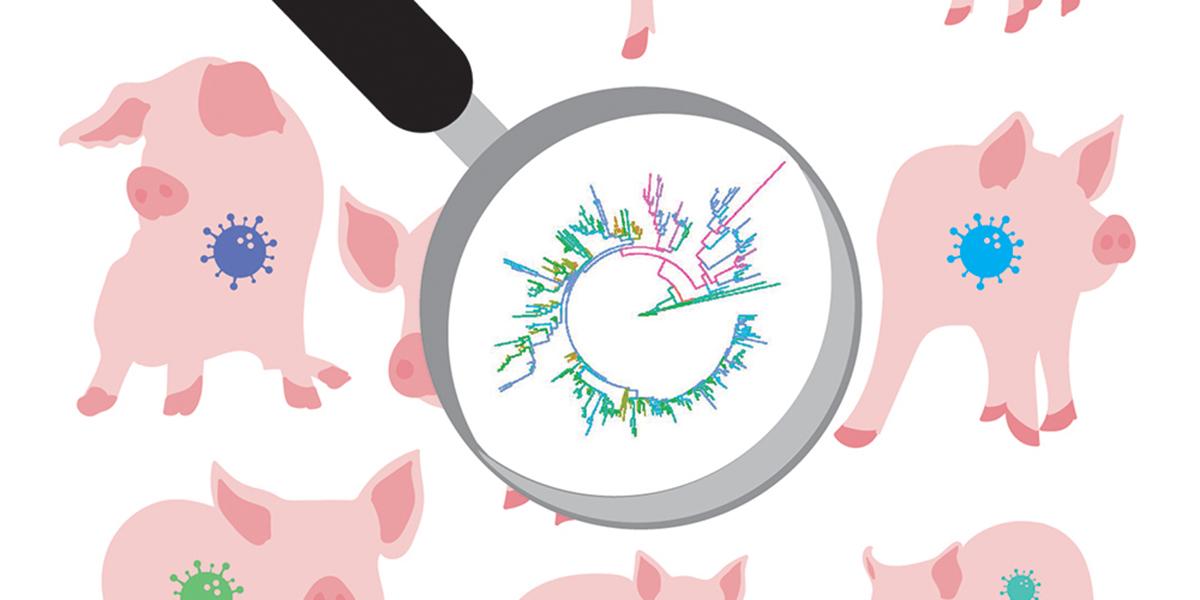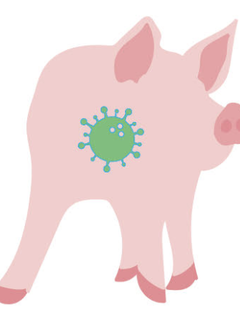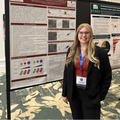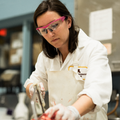Researchers in the Department of Veterinary Population Medicine (VPM) at the University of Minnesota College of Veterinary Medicine (CVM) are collaborating with researchers at the University of Edinburgh’s Roslin Institute to better understand one of the world’s most elusive swine viruses—porcine reproductive and respiratory syndrome (PRRS) virus. The team of scientists recently received a $3 million Ecology and Evolution of Infectious Diseases grant to pursue answers to mitigating the disease. The grant is jointly funded by the National Institute of Food and Agriculture, National Science Foundation, National Institutes of Health, and the United Kingdom Government’s Biotechnology and Biological Sciences Research Council.
PRRS is considered the most important endemic disease that affects pigs in the United States and one of the costliest challenges the industry faces. It is caused by an RNA virus, which naturally produces mutations—and quite a lot of them. Mutations aid the PRRS virus in adapting to evade vaccine-induced or natural immunity. While a host may build immunity to a certain strain of PRRS virus after infection, that strain—as with any virus—can counter-evolve to survive in that host and spread nonetheless. And viruses often compete for hosts—some are better than others at evading the host’s immunity, depending on what that host is used to. This research aims to help farmers understand how the PRRS virus evolves, changes, moves, and persists. It also helps producers explore ways of out-maneuvering PRRS.
The grant will support four major phases of research that will help scientists better understand how different strains of the virus are shaped by their unique environments—and how they can stop it from spreading. Kim VanderWaal, PhD, assistant professor in the VPM, is the principal investigator on the project. She says, “Studying the PRRS virus’s evolution will help us better understand and hopefully control it, but it will also help us understand the evolution and genetic diversity in viruses in humans and other animals.”
The U of M Veterinary Diagnostic Laboratory has been collecting samples of the PRRS virus for nearly three decades. As part of the grant’s research team, Albert Rovira, DVM, PhD, an associate professor in the VPM, and his team will continue to sequence small parts of RNA from the lab’s collection to determine which samples are new variations of the virus. “We also have hundreds of virus isolates saved in the lab’s freezer,” says Rovira, who notes that these isolates could be used to infect pigs during the research.
The team will work with the U of M’s Morrison Swine Monitoring Program, which is coordinated by Cesar Corzo, DVM, MS, PhD, an associate professor in the VPM, and keeps tabs on the PRRS status of roughly 50 percent of the U.S. sow population. “The relationships the U of M has built with the industry over time are very strong, and this project builds directly off of that trust and collaboration,” says VanderWaal. The program functions as a prime example of the power of the partnerships between U of M and the industry.
Declan Schroeder, PhD, an associate professor in the VPM, is a virologist contributing to the project. Schroeder’s lab was able to establish the first-ever evidence that the full genome of PRRS virus is detectable within 24 hours of sampling. He says this research can give veterinarians a better tool to rapidly diagnose the infection in animals. He also says the nature of the team’s collaboration is what makes the research unprecedented. “People have tried one or two components of this project on their own, but we’ve put together a truly interdisciplinary team,” he says. “The whole project can’t function without each member's expertise.”





